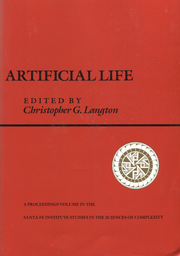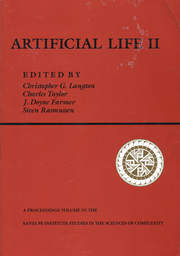Santa Fe Proc vol 6 1988 Artificial Life (Notes)
| Artificial Life by Christopher G. Langton, p. 1-48 |
Artificial Life
Artificial Life, SFI Studies in the Sciences of Complexity, Ed. C. Langton, Addison-Wesely Publishing Company, 1988.
People
Ideas
- Studying synthetic systems that exhibit the behaviors in natural living systems.
- Maybe add unnatural living systems.
- life-as-it-could-be, emphasis the author.
- Life-like behavior is independent from the underlying material.
- With no available extra-terrestrial biology to compare Earth based carbon biology to, Artificial Life is the only comparison available.
- Biology is top down.
- AL is bottom up.
- AL studies emergent behavior. Simple pieces work to together to create complex behaviors with no central control.
- Biology and Reality are both distributed systems.
- Artificiality - Human made to imitate biological behavior with high fidelity.
- Traditional programing, procedural and deterministic state, is inadequate. A dynamic model is needed.
- Open world vs. closed world.
- Ongoing dynamic behavior and not a final result.
- Turing Machine won't do for this.
- The essential features for computer-based AL are:
- They consist of populations of simple programs or specifications
- There is no single program that directs all of the other programs
- Each program describes the way in which a simple entity reacts to local situations in its environment, including interactions with other entities.
- There are no rules in the system that dictate global behavior.
- Any behavior at levels higher than the individual programs is therefore emergent.
Acronyms
AL Artificial Life
References
Internal Links
Parent Article: Reading Notes

